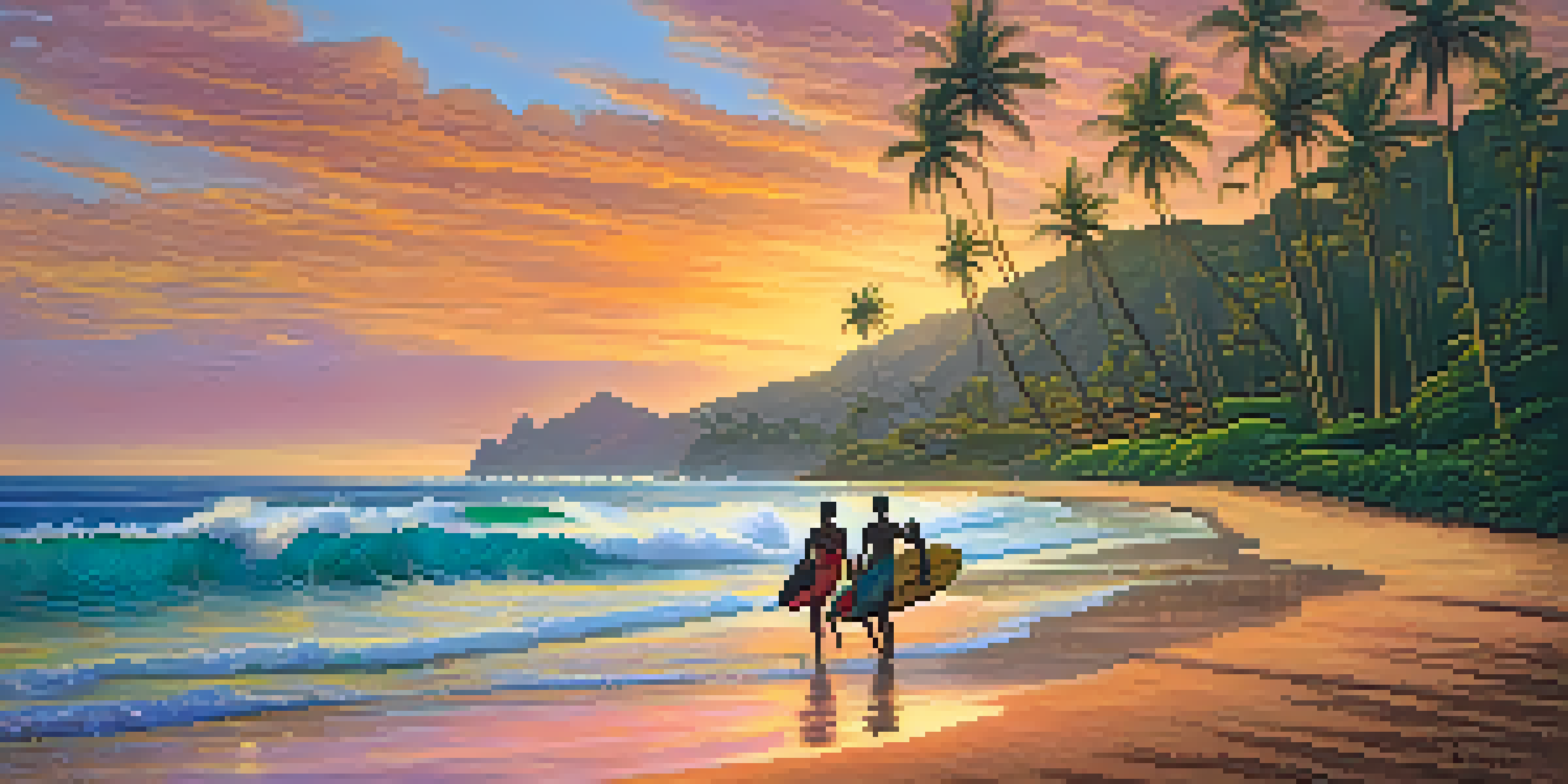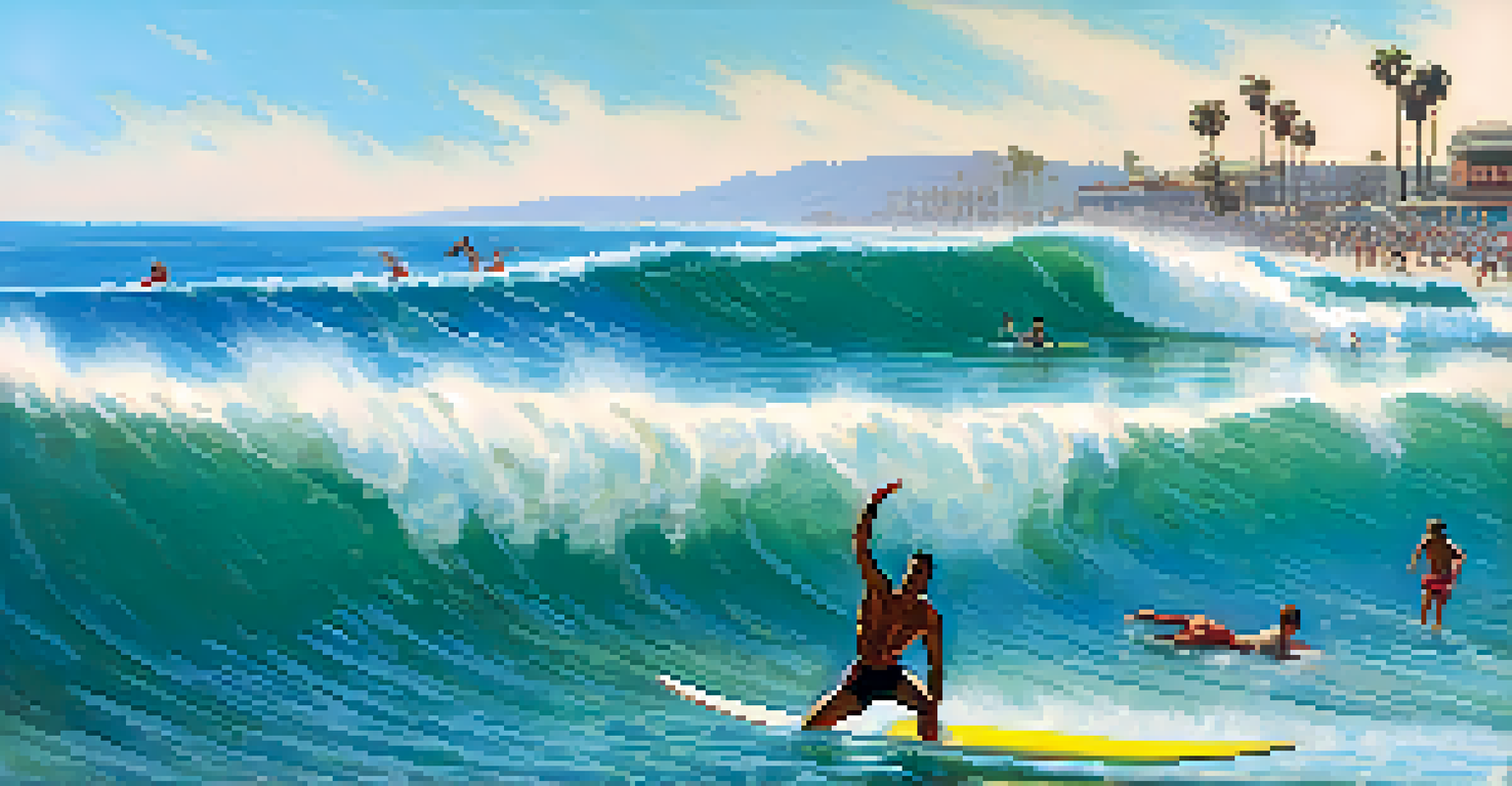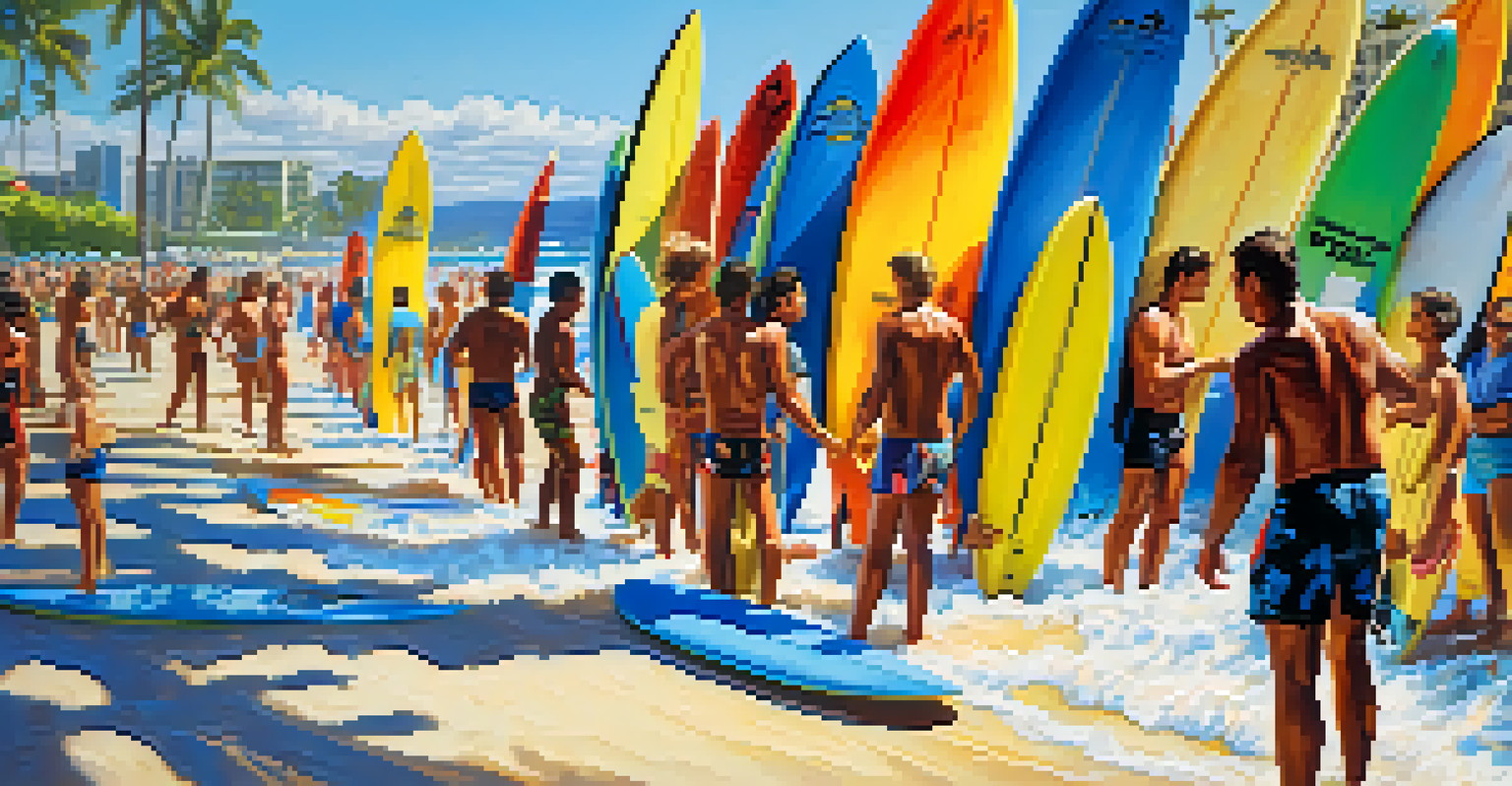The Birth of Surf Culture: Honolulu's Pioneering Influence

The Origins of Surfing in Ancient Hawaii
Surfing, known as heʻe nalu in Hawaiian, has roots that stretch back to ancient Hawaii. The sport was more than just a pastime; it was deeply intertwined with Hawaiian culture and spirituality. Kings and commoners alike would take to the waves, showcasing their skill and bravery on handcrafted wooden boards.
Surfing is the most fun you can have standing up.
These early surfers used longboards, often made from local trees like koa or wiliwili, which were ideal for riding the gentle waves. The act of surfing was often a communal event, fostering camaraderie and a connection to the ocean. This cultural significance laid the foundation for the surfing lifestyle we recognize today.
As European explorers began to arrive in the 18th century, they documented this vibrant sport, capturing the attention of a broader audience. These early encounters set the stage for the global spread of surfing, with Honolulu at the forefront of this cultural exchange.
Duke Kahanamoku: The Face of Surfing
No discussion of surf culture is complete without mentioning Duke Kahanamoku, a Hawaiian legend and Olympic swimmer. Duke is often credited with popularizing surfing beyond Hawaii, introducing the sport to the mainland U.S. and beyond. His charismatic personality and skill on the waves made him an ambassador for the sport.

In the early 20th century, Duke began demonstrating surfing in California, captivating audiences and igniting interest in the sport. He would often perform at beaches like Santa Monica, where crowds gathered to watch him ride the waves with grace and style. This helped to establish surfing as not just a Hawaiian tradition but an American pastime.
Surfing's Cultural Roots in Hawaii
Surfing, or heʻe nalu, is deeply embedded in Hawaiian culture, reflecting a rich history of connection to the ocean.
Duke's influence extended beyond his athletic prowess; he embodied the spirit of aloha, promoting a culture of respect for the ocean and its waves. His legacy lives on, reminding us of the deep connection between surfing and Hawaiian identity.
The Role of Waikiki in Surf Culture
Waikiki, a vibrant neighborhood in Honolulu, played a pivotal role in the development of surf culture in the early 20th century. Its picturesque beaches and consistent waves made it an ideal spot for both locals and tourists to showcase their surfing skills. The area quickly became a hub for surf schools and rental shops, fueling the sport's growing popularity.
The ocean stirs the heart, inspires the imagination, and brings eternal joy to the soul.
As more visitors flocked to Waikiki, the surf scene expanded, with notable figures like George Freeth introducing lessons and demonstrations. This accessibility helped demystify surfing, making it approachable for people of all ages and backgrounds. The beach became a melting pot of cultures, all united by their shared love for the waves.
The influence of Waikiki is still felt today, as it remains a popular destination for surfers and beachgoers alike. Its rich history serves as a testament to the enduring appeal of surf culture and its roots in Hawaiian tradition.
The Evolution of Surfboards: From Wood to Fiberglass
The evolution of surfboards mirrors the growth of surf culture itself, transitioning from traditional wooden boards to modern fiberglass designs. Early surfers relied on heavy, solid wood boards that required significant strength and skill to maneuver. While these boards were beautiful and unique, they were quite challenging to ride.
In the 1950s, a technological revolution introduced lightweight fiberglass boards, changing the game for surfers everywhere. These new boards allowed for greater speed, agility, and maneuverability, appealing to a broader audience eager to catch waves. The shift not only transformed the physical aspect of surfing but also expanded the sport's reach.
Duke Kahanamoku's Lasting Influence
Duke Kahanamoku popularized surfing beyond Hawaii, embodying the spirit of aloha and transforming it into an American pastime.
Today, surfboard design continues to evolve with innovations such as foam cores and high-performance materials. This progress reflects the dynamic nature of surf culture, which thrives on creativity and adaptation while honoring its roots.
The Rise of Surf Competitions and Professionalism
As surfing gained popularity, organized competitions began to emerge, marking a significant shift in the sport's landscape. The first official surf contest took place in 1928 at Makaha Beach, showcasing the talents of local surfers. This event laid the groundwork for the competitive nature of surfing we see today.
With the establishment of professional surfing tours in the 1970s, the sport began to attract sponsorships and media attention. Events like the World Surf League (WSL) brought a new level of professionalism, elevating surfers to celebrity status and inspiring future generations. It transformed surfing from a casual pastime into a viable career path for many.
Despite this commercialization, the essence of surf culture remains rooted in its original values of community, respect for nature, and passion for the ocean. The balance between competition and culture continues to shape the identity of surfing worldwide.
The Influence of Surf Music and Art
Surf culture extends beyond the waves, deeply influencing music and art throughout the decades. The 1960s surf rock movement, led by bands like The Beach Boys, captured the carefree spirit of the beach lifestyle. Their catchy tunes and iconic imagery helped solidify surfing as a cultural phenomenon, appealing to youth around the world.
Artists began to draw inspiration from the vibrant colors and dynamic movements of surfing, leading to a unique genre of surf art. Iconic surf artists like Rick Griffin and John Van Hamersveld illustrated the thrill of riding waves, creating a visual representation of the surf lifestyle. This fusion of art and sport helped to further popularize surfing in mainstream culture.
Global Expansion of Surf Culture
Surf culture has evolved from its Hawaiian origins to become a worldwide phenomenon, enriched by modern technology and diverse regional adaptations.
Today, surf music and art continue to thrive, celebrating the joy and freedom that comes with riding the waves. This creative expression serves as a reminder of the deep connections between surfing, culture, and community.
Surf Culture’s Global Expansion and Modern Influence
Surf culture has transcended its Hawaiian origins, spreading to coasts around the world. From the beaches of California to the shores of Australia and beyond, surfing has become a global phenomenon. Each region has embraced the sport in its own unique way, adapting it to local conditions and cultures.
Modern technology and social media have played a significant role in this expansion, allowing surfers to share their experiences and connect with others worldwide. Platforms like Instagram showcase stunning surf photography and videos, inspiring a new generation of wave riders. This connectivity fosters a sense of community, bridging gaps between diverse surfing cultures.

As surfing continues to evolve, it remains a testament to the spirit of adventure and freedom that it embodies. The global surf community, rooted in the traditions of Honolulu, celebrates the shared love for the ocean and the joy of riding the waves, regardless of where you are.